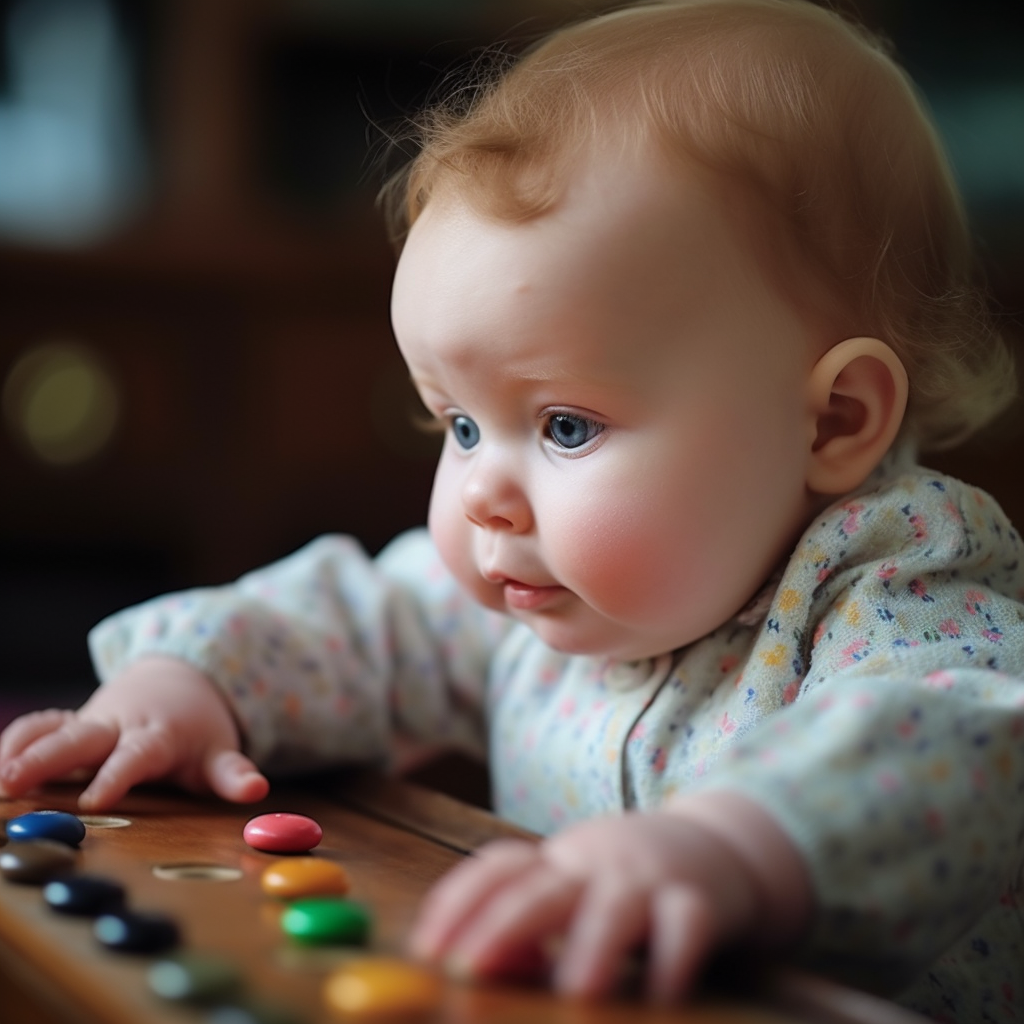ELI5 Summary
Kids are naturally drawn to pressing buttons. But why do they find it so enjoyable? The fascination with buttons can be attributed to several reasons. Firstly, pressing buttons gives children a sense of control and power over their environment. It allows them to make things happen and see immediate results. Secondly, pressing buttons offers a thrilling sense of discovery. Children love to experiment, and buttons provide them with the opportunity to explore cause and effect relationships. They get excited about the unpredictability of what will happen when they press a button. Additionally, pressing buttons stimulates cognitive development. It involves problem-solving and critical thinking as children figure out how buttons work and what they can do. This activity engages their curiosity and enhances their ability to understand cause and effect. Lastly, on a deeper level, the enjoyment of button pressing is rooted in our evolutionary instincts. Humans have an innate desire for control and exploration, which button pressing fulfills. In summary, children love pressing buttons because it gives them a sense of power, allows them to discover new outcomes, stimulates their thinking, and satisfies their instinctual need for control and exploration.
I. Introduction
Kids and buttons: a classic combination that never fails to captivate. From elevators and vending machines to remote controls and toys, children seem to have a magnetic attraction to anything with buttons. Have you ever wondered why?
In this blog post, we will delve into the fascinating world of buttons and explore why kids find pressing them so enjoyable. By the end of this article, you’ll have a comprehensive understanding of the factors that contribute to this irresistible fascination. Let’s dive in and uncover the mysteries of button pressing!
The Fascination of Kids with Buttons If you’ve ever observed a child in the presence of buttons, you’ll notice an immediate glimmer of excitement in their eyes. It’s as if they’ve stumbled upon a treasure trove of joy and curiosity. But what is it about these small, often circular objects that evokes such enthusiasm? Let’s embark on a journey to unravel the secrets behind kids’ fascination with buttons.
Exploring Why Kids Enjoy Pressing Buttons In this blog post, we aim to dissect the reasons behind children’s affinity for pressing buttons. Do they provide sensory delight? Perhaps they offer a sense of control and empowerment? Or is it the thrill of discovering unexpected outcomes? We will explore these aspects and more to shed light on this captivating phenomenon.
Unraveling the Reasons behind this Irresistible Fascination By the end of this article, you’ll gain a comprehensive understanding of why kids enjoy pressing buttons. We’ll examine how buttons provide sensory delight, empower children, stimulate their cognitive abilities, and even tap into evolutionary instincts.
The mysteries of this ubiquitous childhood fascination will be unraveled, leaving you with a newfound appreciation for this simple, yet captivating, activity. So, fasten your seatbelts and get ready to embark on this fascinating exploration of kids and buttons!
II. The Intrigue of Buttons
Buttons are irresistible to kids not only because of their intriguing visuals but also because they offer a delightful sensory experience. Let’s dive deeper into the sensory aspects that make button pressing so captivating for children.
Appeal to the Sense of Touch
Think about the satisfaction you feel when you press a button and feel the gentle resistance beneath your fingertip. Children are no different in their appreciation for this tactile sensation. The smooth or textured surface of a button invites them to explore with their fingertips, creating a sensory connection that is both satisfying and intriguing. The physical act of pressing a button and feeling the response provides an immediate sense of engagement and interaction.
Visual Impact and Immediate Response
Buttons often come in vibrant colors, contrasting shapes, and eye-catching designs that instantly grab a child’s attention. Whether they are big and round, small and square, or decorated with playful icons, buttons provide a visual feast for curious young minds. Additionally, the immediate response they elicit—such as a light turning on or a sound being produced—creates a sense of cause and effect that taps into a child’s inherent curiosity.
Auditory Feedback and the Satisfaction of Sound
One of the most rewarding aspects of pressing buttons is the accompanying sound. From the satisfying “click” of a mechanical button to the beep or boop from a digital interface, the auditory feedback enhances the overall experience for children. These sounds offer confirmation that their action has initiated a response, further fueling their engagement and enjoyment. The combination of tactile, visual, and auditory sensations makes button pressing a multisensory delight for kids.
In summary, buttons provide a sensory playground for children. The tactile experience, visual appeal, and the immediate auditory feedback all contribute to the allure of button pressing. This sensory delight is just one piece of the puzzle in understanding why kids enjoy this activity so much. In the next section, we’ll explore the power of control and how it empowers children in their fascination with buttons.
III. The Power of Control
Empowerment and Autonomy Children are naturally drawn to activities that offer them a sense of control and autonomy. Button pressing provides precisely that, making it an appealing activity for young minds. Let’s explore the ways in which buttons empower children and contribute to their fascination.
Button Pressing as a Means of Control
Imagine being a child in a world where adults make most of the decisions. Pressing buttons gives children a tangible way to exert control over their immediate environment. Whether it’s activating a toy, turning on a light, or even selecting a TV channel, buttons allow kids to initiate actions and see direct outcomes. This sense of control instills a feeling of agency, as they realize that their actions can influence the world around them.
Sense of Achievement and Accomplishment
When a child successfully presses a button and observes the desired outcome, it generates a sense of achievement and accomplishment. This small victory reinforces their belief in their abilities and fuels their desire for more. The immediate feedback loop of cause and effect cultivates a positive reinforcement system, making button pressing a rewarding activity that encourages further exploration.
By offering a sense of control and providing a pathway for achievement, buttons become a source of empowerment for children. The ability to make things happen with a simple press enhances their self-confidence and nurtures their developing autonomy. In the next section, we’ll uncover the thrill of discovery and how it contributes to the enjoyment of button pressing.
IV. The Thrill of Discovery: Unveiling Outcomes
Button pressing presents children with a fascinating world of discovery. It allows them to explore cause and effect relationships, unraveling the mysteries of how things work. Let’s delve into the excitement of discovery and how it contributes to the joy that kids find in pressing buttons.
Experimentation and Unpredictability
Children are natural scientists, constantly seeking to understand the world around them. Buttons offer an opportunity for hands-on experimentation. Each press holds the promise of a different outcome, encouraging children to engage in a process of trial and error. The element of unpredictability adds thrill and excitement, keeping them intrigued and fueling their curiosity.
Immediate Cause and Effect Connections
With button pressing, children can experience immediate cause and effect connections. By observing the outcome of their actions, they begin to grasp the concept of cause leading to an effect. This tangible cause-effect relationship sparks cognitive development and allows them to form a deeper understanding of how their actions can influence the world.
The thrill of discovering what happens when a button is pressed creates a sense of wonder and exhilaration. Each press becomes a small adventure, unveiling new outcomes and expanding their knowledge of the world’s inner workings. In the next section, we’ll dive into the cognitive stimulation that button pressing provides and how it contributes to children’s fascination with this activity.
V. Cognitive Stimulation: Curiosity and Problem-Solving
Button pressing not only captivates children’s senses but also stimulates their cognitive abilities. It fosters curiosity and provides opportunities for problem-solving, making it an intellectually engaging activity. Let’s explore how buttons act as puzzles to be solved and support the development of problem-solving skills.
Buttons as Puzzles to Solve
With their various shapes, sizes, and functions, buttons present children with puzzles to unravel. They are like tiny mysteries waiting to be solved. As children experiment with different buttons, they observe how each one triggers a specific response or action. This process of exploration prompts their curiosity and motivates them to seek answers to questions like “What does this button do?” or “How can I make this button work?” By figuring out the functionality of buttons, children engage in critical thinking and problem-solving activities.
Development of Problem-Solving Skills
Button pressing requires children to engage in problem-solving at a basic level. They learn to observe, analyze, and make connections between cause and effect. By experimenting with buttons, children develop their cognitive skills, including logical reasoning, spatial awareness, and understanding of sequence and patterns. Furthermore, this problem-solving aspect of button pressing promotes their ability to think creatively and adapt their approach.
As they encounter new buttons or encounter unexpected outcomes, children learn to adjust their strategies and expand their problem-solving repertoire. The cognitive stimulation provided by button pressing enhances children’s intellectual growth. By engaging in problem-solving and exercising their curiosity, they develop foundational cognitive skills that will serve them well as they navigate the world. In the next section, we’ll explore the psychological factors that contribute to the enjoyment of button pressing and why it brings pleasure to children.
VI. Evolutionary Instincts: Pleasure and Engagement
The fascination that children have with button pressing goes beyond sensory delight, control, discovery, and cognitive stimulation. It taps into deeper psychological factors rooted in our evolutionary instincts. Let’s explore why button pressing brings pleasure and engages children on a primal level.
Satisfaction of Immediate Gratification
Humans are wired to seek immediate gratification. Button pressing offers an instant response, which satisfies this innate desire for immediate reward. The quick feedback loop of cause and effect provides a sense of instant gratification and pleasure for children. It reinforces their engagement with button pressing, as they associate it with a pleasurable experience.
Sensory and Motor Engagement
Button pressing engages both sensory and motor skills, providing a holistic experience for children. The combination of tactile sensations, visual stimuli, auditory feedback, and the physical act of pressing a button stimulates multiple senses simultaneously. This heightened sensory engagement intensifies the experience and amplifies the pleasure derived from button pressing.
Evolutionary Significance of Control and Exploration
From an evolutionary standpoint, the desire for control and exploration is deeply ingrained in human nature. In our ancestors’ quest for survival and adaptation, curiosity and a drive for exploration played crucial roles.
Button pressing allows children to engage in these evolutionary instincts. The sense of control and the thrill of discovery satisfy these deeply rooted desires, creating a sense of pleasure and engagement. The joy and pleasure children find in button pressing can be attributed to these primal psychological factors deeply embedded within us. As they engage in this seemingly simple activity, they are unknowingly connected to our shared evolutionary heritage.
VII. Conclusion
Kids and buttons form an enthralling duo that never fails to captivate. Through exploring sensory delight, the power of control, the thrill of discovery, cognitive stimulation, and evolutionary instincts, we’ve unraveled the enchantment behind children’s fascination with button pressing. From the tactile pleasure to the opportunities for problem-solving, children find joy, engagement, and intellectual growth in this seemingly simple activity.
Next time you see a child eagerly pressing buttons, remember the multitude of reasons that contribute to their fascination. Buttons offer more than just a momentary distraction; they provide a rich learning experience, stimulate cognitive development, and tap into our innate desires for control and exploration. So, the next time you encounter a child with excitement in their eyes and a button within their reach, encourage their exploration and appreciate the magic that lies behind this timeless fascination.



